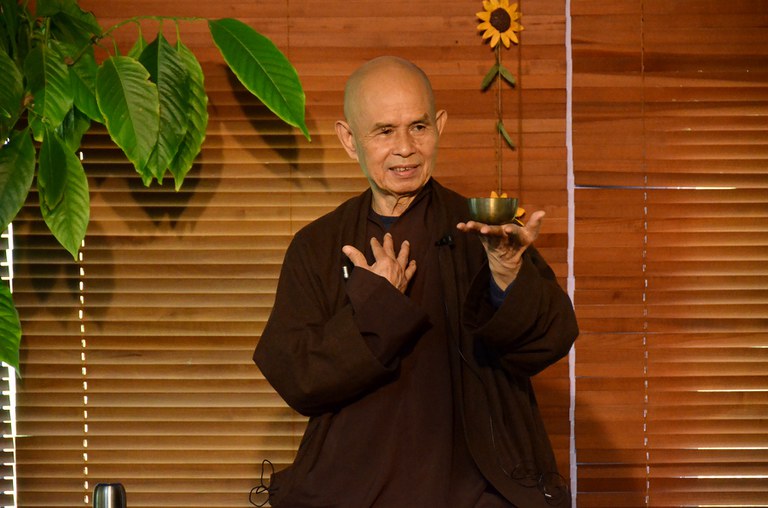Mindfulness is a practice that encompasses a range of techniques designed to cultivate an intentional focus on the present moment, while fostering non-judgmental observation and deeper insight into the nature of reality. Through this deliberate training of the mind, individuals can attain a sense of inner peace, contentment and personal growth.
In this article, LotusBuddhas will elucidate the history, meaning, and practical application of mindfulness in daily life to enable individuals to reap the myriad benefits associated with this practice.
Meaning of Mindfulness in Buddhism

Mindfulness, derived from Pali word “sati,” is a core concept in Buddhism, playing a pivotal role in the teachings and practices of this ancient spiritual tradition. Rooted in the Satipatthana Sutta, a central discourse attributed to the Buddha, mindfulness involves the cultivation of moment-to-moment awareness of one’s body, feelings, mind, and mental phenomena, enabling individuals to develop insight and attain liberation from suffering.
“Mindfulness is like a string that holds a kite up high in the sky without being swept away by the wind.”
At its essence, mindfulness entails the deliberate and non-judgmental attention to one’s experiences in the present moment. This focused awareness is cultivated through various meditation practices, such as breath awareness, body scanning, and contemplation of the impermanence of all phenomena. By fostering a deep connection to the present, mindfulness allows practitioners to observe their thoughts and emotions without attachment or aversion, thus fostering equanimity and reducing reactivity to life’s inevitable challenges.
Mindfulness serves as a foundational element in the Eightfold Path, which is the Buddha’s prescription for the cessation of suffering (dukkha) and the attainment of enlightenment. As the seventh factor of this path, mindfulness (sati) works in conjunction with right effort (sammā-vāyāma) and right concentration (sammā-samādhi) to form the “concentration” or “mental cultivation” division of the path, ensuring the development of mental clarity, wisdom and ultimately, liberation.
In the context of Buddhist philosophy, mindfulness also contributes to the cultivation of the Four Foundations of Mindfulness (satipatthana), which are essential aspects of meditation practice. These foundations include mindfulness of the body (kāyānupassanā), feelings (vedanānupassanā), consciousness (cittānupassanā), and mental objects (dhammānupassanā). By attentively observing these four aspects of experience, practitioners can gain insight into the Three Marks of Existence – impermanence (anicca), unsatisfactoriness (dukkha), and non-self (anatta) – which ultimately leads to the cessation of suffering and the realization of enlightenment.
Correct and Incorrect Understandings of Mindfulness
Incorrect Understandings of Mindfulness
Incorrect understandings of mindfulness often stem from a lack of knowledge about the interplay of attention, thought, and consciousness. A subtle point that is often misunderstood is that the content of consciousness is driven by what attention seeks and activates, leading many to mistakenly believe that attention itself is the knowing consciousness. Therefore, within the Buddhist study community, mindfulness is commonly misinterpreted as “knowing the truth of the object,” or “wisdom regarding the object,” confusing mindfulness with the knowing consciousness of Right View.
Due to such misunderstandings, a prevalent practice in the Buddhist community goes like this: “When walking, know that you are walking; when eating, know that you are eating; when picking vegetables, know that you are picking vegetables….” Such practice is actually the cultivation of the knowing consciousness. In this practice, there emerges an ego that acts as the owner of actions like walking, eating, and picking vegetables, which is a cultivation based on a distorted view of knowing consciousness.
Correct Understandings of Mindfulness
To accurately understand mindfulness, it is essential to comprehend the four aspects of Right Mindfulness: the truth about Right Mindfulness, the arising of Right Mindfulness, the cessation of Right Mindfulness, and the path to its cessation.
A wise disciple of Buddha Shakyamuni gains Prudence Wisdom by listening to teachings or studying the scriptures. This wisdom entails a correct understanding of phenomena based on the foundation of MIND KNOWING MIND, recognizing the true nature of objects perceived, heard, or felt as Sensations (Feelings) arising from contact with the senses, which are impermanent, ownerless, and non-self.
Such a person correctly understands the aspects of Suffering, its Origin, Cessation, and the Path internal to the MIND rather than external WORLDLY circumstances. They comprehend the conditioned arising of the mind on the path of Wrong Practices with ignorance, desire, aversion, sorrow, lamentation, pain, grief, and despair, and recognize the conditioned arising of the path to end Suffering, which is the mind’s journey on the Right Path with right mindfulness, concentration, and wisdom, achieving the liberations of Emptiness, Signlessness, and Aimlessness. This understanding, gained through listening, is stored in the repository of knowledge called Prajna Wisdom.
When contact occurs and FEELING – < Perception – Thought > arises followed by the arising of mindfulness, if that mindfulness REMEMBERS Prajna Wisdom, recalling what has been learned, then that mindfulness is RIGHT MINDFULNESS. In summary, Right Mindfulness is the True Recollection, recalling accurate information about the reality of things and phenomena (Prajna Wisdom). This defines the truth about Right Mindfulness.
7 Principles of Mindfulness

The 7 principles of mindfulness are a set of guidelines that help individuals incorporate mindfulness into their daily lives and promote mental well-being. These principles are:
- Non-judging: Accepting experiences as they are, without judgment or evaluation. This means letting go of judgment and criticism and embracing an open and accepting attitude towards one’s thoughts and feelings.
- Patience: Being patient and allowing experiences to unfold in their own time, without trying to control or force them.
- Beginner’s mind: Approaching experiences with curiosity and a sense of wonder, as if encountering them for the first time. This helps to counteract preconceptions and habitual ways of thinking.
- Trust: Trusting in one’s ability to handle experiences, even if they are difficult or challenging.
- Non-striving: Letting go of the need to achieve specific goals and outcomes, and instead focusing on the present moment.
- Acceptance: Accepting and embracing experiences, including negative emotions and physical sensations, rather than fighting against them.
- Letting go: Releasing attachment to past experiences and future expectations, instead focusing on the present moment.
Benefits of Practicing Mindfulness

Mindfulness offers numerous benefits for individuals. In addition to enhancing focus, mindfulness also boosts mental health and is beneficial for daily life, work, relationships, and physical health. Specifically, the benefits of mindfulness include:
- Improved memory and cognitive abilities
- Enhanced sleep quality
- Increased sense of happiness
- Relief from stress, depression, and anxiety
- Reduction in symptoms of migraines and chronic pain
- Improved connections and interactions with others
- Assistance in weight loss and improvement of eating disorders
Reduced Stress
Mindfulness practices have been shown to lower cortisol levels, the hormone associated with stress. A study published in the journal “Health Psychology” demonstrates that mindfulness meditation can reduce the body’s response to stress, contributing to a calmer and more composed demeanor.
Enhanced Focus and Concentration
Engaging in mindfulness exercises can improve your ability to focus and maintain attention. Research in the journal “Psychological Science” suggests that mindfulness training can bolster cognitive focus and reduce mind-wandering, which is often a significant impediment to productivity.
Improved Emotional Regulation
Mindfulness helps individuals become more aware of their emotional states and the triggers that exacerbate negative feelings. This awareness fosters better management of emotions. According to a study in the “Journal of Biobehavioral Medicine,” mindfulness can lead to lower emotional reactivity and greater regulation of emotion-related brain function.
Decreased Anxiety and Depression
Regular mindfulness practice has been linked to reductions in symptoms of anxiety and depression. A meta-analysis in “JAMA Internal Medicine” found that mindfulness meditation programs had moderate evidence of improved anxiety, depression, and pain outcomes.
Better Physical Health
Beyond mental benefits, mindfulness can positively impact physical health. For example, it has been associated with lower blood pressure, improved sleep, and a stronger immune system. A study in “Psychosomatic Medicine” showed that mindfulness meditation was associated with changes in markers of inflammation, cell-mediated immunity, and biological aging.
Enhanced Self-Awareness
Mindfulness cultivates a deeper understanding of oneself. By paying attention to your thoughts and feelings without judgment, you can gain insights into your behaviors and motivations, leading to personal growth and self-improvement.
Incorporating mindfulness into your daily routine can be a transformative experience, offering benefits that permeate all facets of life. Whether it’s through formal meditation, mindful walking, or simply being present in the moment, the practice of mindfulness is a powerful tool for enhancing well-being and overall quality of life.
How to Practice Mindfulness in Daily Life
As LotusBuddhas has shared, mindfulness has transcended the realm of Buddhist monastic practice and has become a widely adopted practice in various religious and non-religious communities.
More and more individuals are integrating mindfulness into their daily routines and activities to deepen their relationship with their experiences, promote a heightened sense of presence, clarity and profound understanding. If you are interested in incorporating mindfulness into your daily life, the following suggestions provide guidance on how to practice mindfulness:
Breathing Exercise
This is an excellent opportunity to dedicate some time to yourself and practice mindfulness every day. To engage in a breathing exercise, you can:
- Sit comfortably with a straight back.
- For one minute, focus your attention solely on your breath.
- Breathe naturally and notice the intervals between inhaling and exhaling.
- Feel your lungs expand and your abdomen move with each breath.
- Whenever your mind wanders, gently redirect your focus back to your breath.
Awareness of Thoughts and Emotions
Mindfulness doesn’t eliminate thoughts and stress but helps you recognize that these emotions are transient. To practice mindfulness:
- Ask yourself: “What am I experiencing right now?”
- Label your thoughts and emotions, for example, “This is anxiety.”
- Avoid judging yourself; instead, observe and assess whether the anxiety is warranted.
- If you deem the stress and anxiety insignificant, let it go and focus on the present.
- If the stress or anxiety is overwhelming, consider seeking help from mental health professionals, family, friends, or mentors to address and resolve the issue.
Mindful Eating
Eating mindfully means focusing entirely on your meal without distractions like watching TV, reading, or using your phone. To practice mindful eating:
- Pay attention to the appearance and colors of your food.
- Savor the flavors and aromas.
- Stop eating when you feel full, instead of feeling compelled to finish everything on your plate.
Mindful Walking
You can practice mindful walking at any time of the day. Start slowly, and as you become accustomed, you can practice it at any pace, even when hurrying. To engage in mindful walking:
- Feel the sensation of your feet touching the ground, regardless of the surface (grass, beach, wood, concrete, etc.).
- Be aware of the muscle groups you use while walking.
- When your mind drifts, use the contact of your feet with the ground as an anchor to bring you back to the present.
- Dedicate at least one minute daily to focus on the sensation of walking.
Incorporating these mindfulness practices into your day can help you develop greater self-awareness, reduce stress, and enhance your enjoyment of life’s simple pleasures.
Tips for Practicing Mindfulness for Beginners
If you’re finding it challenging to practice mindfulness, the following tips may be helpful:
- Focus on doing one task at a time. Trying to multitask can lead to a loss of focus, so aim to devote your full attention to one activity with utmost concentration.
- Be kind to yourself while practicing mindfulness. Do not judge or berate yourself if your mind wanders. Mindfulness is also about accepting yourself and treating yourself with compassion. Take the time to focus on the present and allow yourself the space to grow.
- Set a specific time each day to practice mindfulness and maintain this routine consistently. You can practice mindfulness during meals, walks, or conversations to enhance your awareness of the present moment.
Understanding the concept of mindfulness and being aware of its benefits can motivate you to start learning and practicing it right away. While mindfulness offers many advantages, it is not necessarily suitable for everyone. Some individuals may find that mindfulness does not help them control anxiety and stress; in such cases, seeking help from a psychologist might be a better solution.
Furthermore, some healthcare professionals believe that mindfulness may not be appropriate for people with certain mental disorders. In some instances, practicing mindfulness in deep meditation can cause anxiety or detachment from reality for individuals with mental health disorders.








